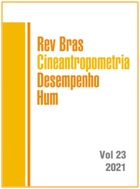Assessment methods of vastus lateralis muscle architecture using panoramic ultrasound: a new approach, test-retest reliability and measurement error
DOI:
https://doi.org/10.1590/1980-0037.2021v23e76402Resumen
Extended-field-of-view ultrasonography is a valid alternative to determine the dimensions of the skeletal striated muscle; however, some factors may influence the final measurement. The aim of this study was to determine the test-retest reliability and measurement error of vastus lateralis muscle architecture variables through internal anatomical landmarks and to compare three fixed determined points using extended-field-of-view ultrasonography. Twelve young (24 ± 6 years) adult university male students participated in the study. Images were obtained through extended-field-of-view ultrasonography of the vastus lateralis muscle. Measurements were made for muscle thickness (MT), fascicle length (FL), and fascicle pennation angle (FA) using a method that identifies internal anatomical landmarks. MT was also measured at predetermined distances of 2 cm proximal, 6 cm proximal, and 2 cm distal. One-way ANOVA with repeated measures did not identify any test-retest significant differences for all variables measured. Typical measurement error in centimeters (cm) or degrees (º), coefficient of variation in percentage (%) and intraclass correlation coefficient were MT = 0.07 cm, 2.93%, 0.964; FL = 0.31 cm, 2.89%, 0.947; FA = 0.92°, 4.08%, 0.942; MT 2 cm proximal = 0.10 cm, 3.77%, 0.910; MT 6 cm proximal = 0.27 cm, 9.66%, 0.576; MT 2 cm distal = 0.35 cm, 19.76%, 0.564. MT, FL and FA showed high reliability and low measurement error. Internal anatomical landmarks proved to be more reliable and presented smaller measurement errors when compared to the predetermined distances method.
Citas
Blazevich AJ, Cannavan D, Coleman DR, Horne S. Influence of concentric and eccentric resistance training on architectural adaptation in human quadriceps muscles. J Appl Physiol. 2007;103(5):1565-75.
Franchi M V., Raiteri BJ, Longo S, Sinha S, Narici M V., Csapo R. Muscle architecture assessment: strengths, shortcomings and new frontiers of in vivo imaging techniques. Ultrasound Med Biol. 2018;44(12):2492-504.
Friederich JA, Brand RA. Muscle fiber architecture in the human lower limb. J Biomech. 1990;23(1):91-5.
Bénard MR, Becher JG, Harlaar J, Huijing PA, Jaspers RT. Anatomical information is needed in ultrasound imaging of muscle to avoid potentially substantial errors in measurement of muscle geometry. Muscle and Nerve. 2009;39(5):652-65.
Kellis E, Galanis N, Natsis K, Kapetanos G. Validity of architectural properties of the hamstring muscles: correlation of ultrasound findings with cadaveric dissection. J Biomech. 2009;42(15):2549-54.
Dupont AC, Sauerbrei EE, Fenton P V., Shragge PC, Loeb GE, Richmond FJR. Real-time sonography to estimate muscle thickness: Comparison with MRI and CT. J Clin Ultrasound. 2001;29(4):230-6.
Sipilä S, Suominen H. Muscle ultrasonography and computed tomography in elderly trained and untrained women. Muscle and Nerve. 1993;16(3):294-300.
Ema R, Wakahara T, Miyamoto N, Kanehisa H, Kawakami Y. Inhomogeneous architectural changes of the quadriceps femoris induced by resistance training. Eur J Appl Physiol. 2013;113(11):2691-703.
Wakahara T, Ema R, Miyamoto N, Kawakami Y. Increase in vastus lateralis aponeurosis width induced by resistance training: implications for a hypertrophic model of pennate muscle. Eur J Appl Physiol. 2015;115(2):309-16.
Devrimsel G, Metin Y, Beyazal MS. Short-term effects of neuromuscular electrical stimulation and ultrasound therapies on muscle architecture and functional capacity in knee osteoarthritis: a randomized study. Clin Rehabil. 2019;33(3):418-27.
Blazevich AJ, Cannavan D, Waugh CM, Miller SC, Thorlund JB, Aagaard P, et al. Range of motion, neuromechanical, and architectural adaptations to plantar flexor stretch training in humans. J Appl Physiol. 2014;117(5):452-62.
César EP, Teixeira LO, de Souza DVBC, Gomes PSC. Acute effects of passive static stretching on the vastus lateralis muscle architecture of healthy young men. Braz J Kinathrop Hum Perform. 2017;19(5):585-95.
Weng L, Tirumalai AP, Lowery CM, Nock LF, Gustafson DE, von Behren PL KJ. US extended-field-of-view imaging technology. Radiology. 1997;203(3):877-80.
Noorkoiv M, Nosaka K, Blazevich AJ. Assessment of quadriceps muscle cross-sectional area by ultrasound extended-field-of-view imaging. Eur J Appl Physiol. 2010;109(4):631-9.
Kawakami Y, Abe T, Kuno SY, Fukunaga T. Training-induced changes in muscle architecture and specific tension. Eur J Appl Physiol Occup Physiol. 1995;72(1-2):37-43.
Finni T, Ikegawa S, Lepola V, Komi P V. Comparison of force-velocity relationships of vastus lateralis muscle in isokinetic and in stretch-shortening cycle exercises. Acta Physiol Scand. 2003;177(4):483-91.
Blazevich AJ, Gill ND, Zhou S. Intra- and intermuscular variation in human quadriceps femoris architecture assessed in vivo. J Anat. 2006;209(3):289-310.
Descargas
Publicado
Número
Sección
Licencia

Direitos Autorais para artigos publicados nesta revista são do autor, com direitos de primeira publicação para a revista. Em virtude da aparecerem nesta revista de acesso público, os artigos são de uso gratuito, com atribuições próprias, em aplicações educacionais e não-comerciais, desde que seja dada a atribuição. Esta obra foi licenciada com uma Licença Creative Commons Atribuição 4.0 Internacional - CC BY


